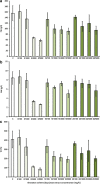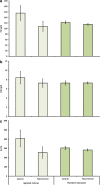Improved production of dibenzocyclooctadiene lignans in the elicited microshoot cultures of Schisandra chinensis (Chinese magnolia vine)
- PMID: 29181570
- PMCID: PMC5756551
- DOI: 10.1007/s00253-017-8640-7
Improved production of dibenzocyclooctadiene lignans in the elicited microshoot cultures of Schisandra chinensis (Chinese magnolia vine)
Abstract
Dibenzocyclooctadiene lignans are a specific group of secondary metabolites that occur solely in Schisandra chinensis. The aim of the presented work was to boost the accumulation of lignans in the agitated microshoot cultures of S. chinensis, using different elicitation schemes. The experiments included testing of various concentrations and supplementation times of cadmium chloride (CdCl2), chitosan (Ch), yeast extract (YeE), methyl jasmonate (MeJa), and permeabilizing agent-dimethylsulfoxide (DMSO). After 30 days, the microshoots were harvested and evaluated for growth parameters and lignan content by LC-DAD method. The analyses showed enhanced production of lignans in the elicited S. chinensis microshoots, whereas the respective media samples contained only trace amounts of the examined compounds (< 5 mg/l). Elicitation with CdCl2 caused up to 2-fold increase in the total lignan content (max. ca. 730 mg/100 g DW after the addition of 1000 μM CdCl2 on the tenth day). Experiments with chitosan resulted in up to 1.35-fold increase in lignan concentration (max. ca. 500 mg/100 g DW) after the supplementation with 50 mg/l on the first day and 200 mg/l on the tenth day. High improvement of lignan production was also recorded after YeE elicitation. After the elicitation with 5000 mg/l of YeE on the first day of the growth period, and with 1000 and 3000 mg/l on the 20th day, the lignan production increased to the same degree-about 1.8-fold. The supplementation with 1000 mg/l YeE on the 20th day of the growth cycle was chosen as the optimal elicitation scheme, for the microshoot cultures maintained in Plantform temporary immersion system-the total content of the estimated lignans was equal to 831.6 mg/100 g DW.
Keywords: Abiotic elicitors; Biotic elicitors; Elicitation; In vitro cultures; Schisandra lignan production; Temporary-immersion bioreactor.
Conflict of interest statement
Conflict of interest
The authors declare that they have no conflict of interest.
Ethical approval
This article does not contain any studies with human participants or animals performed by any of the authors
Figures





Similar articles
-
Stimulation of Lignan Production in Schisandra rubriflora In Vitro Cultures by Elicitation.Molecules. 2022 Oct 7;27(19):6681. doi: 10.3390/molecules27196681. Molecules. 2022. PMID: 36235218 Free PMC article.
-
Schisandra lignans production regulated by different bioreactor type.J Biotechnol. 2017 Apr 10;247:11-17. doi: 10.1016/j.jbiotec.2017.02.007. Epub 2017 Feb 14. J Biotechnol. 2017. PMID: 28223005
-
Accumulation of dibenzocyclooctadiene lignans in agar cultures and in stationary and agitated liquid cultures of Schisandra chinensis (Turcz.) Baill.Appl Microbiol Biotechnol. 2016 May;100(9):3965-77. doi: 10.1007/s00253-015-7230-9. Epub 2015 Dec 21. Appl Microbiol Biotechnol. 2016. PMID: 26685855 Free PMC article.
-
An overview of neuroprotective and cognitive enhancement properties of lignans from Schisandra chinensis.Biomed Pharmacother. 2018 Jan;97:958-968. doi: 10.1016/j.biopha.2017.10.145. Epub 2017 Nov 7. Biomed Pharmacother. 2018. PMID: 29136774 Review.
-
Analysis of Schisandra chinensis and Schisandra sphenanthera.J Chromatogr A. 2009 Mar 13;1216(11):1980-90. doi: 10.1016/j.chroma.2008.09.070. Epub 2008 Sep 26. J Chromatogr A. 2009. PMID: 18849034 Review.
Cited by
-
Differential induction of antioxidant and anti-inflammatory phytochemicals in agitated micro-shoot cultures of Ajuga integrifolia Buch. Ham. ex D.Don with biotic elicitors.AMB Express. 2021 Oct 18;11(1):137. doi: 10.1186/s13568-021-01297-3. AMB Express. 2021. PMID: 34661766 Free PMC article.
-
Impacts of elicitors on metabolite production and on antioxidant potential and tyrosinase inhibition in watercress microshoot cultures.Appl Microbiol Biotechnol. 2022 Jan;106(2):619-633. doi: 10.1007/s00253-021-11743-8. Epub 2022 Jan 5. Appl Microbiol Biotechnol. 2022. PMID: 34985568 Free PMC article.
-
Enhanced accumulation of harpagide and 8-O-acetyl-harpagide in Melittis melissophyllum L. agitated shoot cultures analyzed by UPLC-MS/MS.PLoS One. 2018 Aug 22;13(8):e0202556. doi: 10.1371/journal.pone.0202556. eCollection 2018. PLoS One. 2018. PMID: 30133513 Free PMC article.
-
A Novel Phaeoacremonium Species Isolated from Galls on the Chinese Magnolia-Vine (Schisandra chinensis) in Korea.Mycobiology. 2025 Feb 14;53(2):243-249. doi: 10.1080/12298093.2024.2438463. eCollection 2025. Mycobiology. 2025. PMID: 40098943 Free PMC article. Review.
-
Stimulation of Lignan Production in Schisandra rubriflora In Vitro Cultures by Elicitation.Molecules. 2022 Oct 7;27(19):6681. doi: 10.3390/molecules27196681. Molecules. 2022. PMID: 36235218 Free PMC article.
References
-
- Angelova Z, Georgiev S, Roos W. Elicitation of plants. Biotechnol Biotechnol Equip. 2006;20(2):72–83. doi: 10.1080/13102818.2006.10817345. - DOI
-
- Arroo RRJ, Alfermann AW, Medarde M, Petersen M, Pras N, Woolley JG. Plant cell factories as a source for anti-cancer lignans. Phytochem Rev. 2002;1(1):27–35. doi: 10.1023/A:1015824000904. - DOI
-
- Bahabadi ES, Sharifi M, Safaie N, Murata J, Yamagaki T, Satake H. Increased lignan biosynthesis in the suspension cultures of Linum album by fungal extracts. Plant Biotechnol Rep. 2011;5(4):367–373. doi: 10.1007/s11816-011-0190-3. - DOI
-
- Capote A. Increased cardenolides production by elicitation of Digitalis lanata shoots cultured in temporary immersion systems. Plant Cell Tissue Organ Cult. 2012;110(1):153–162. doi: 10.1007/s11240-012-0139-4. - DOI
MeSH terms
Substances
Grants and funding
LinkOut - more resources
Full Text Sources
Other Literature Sources

